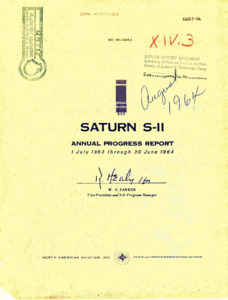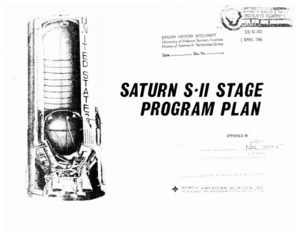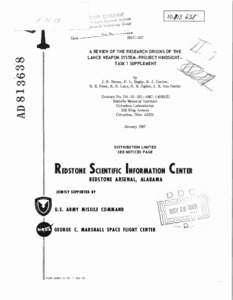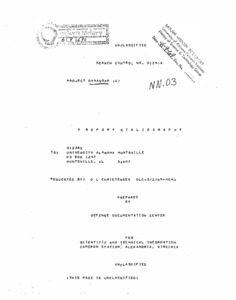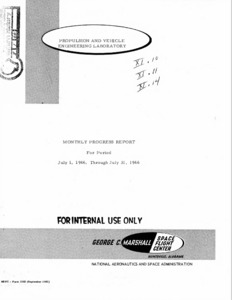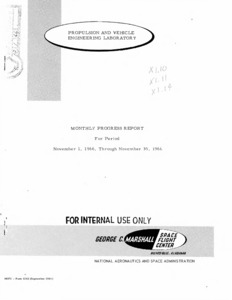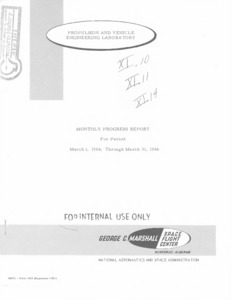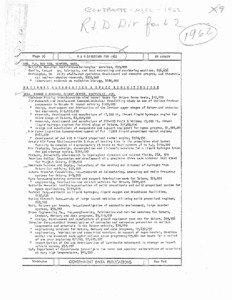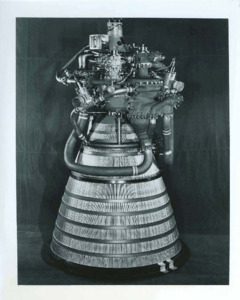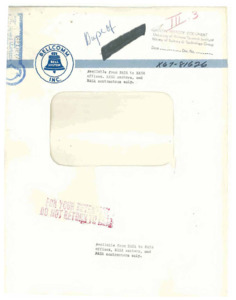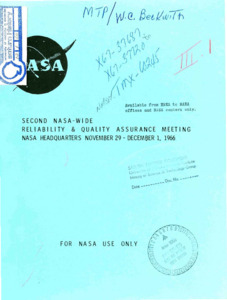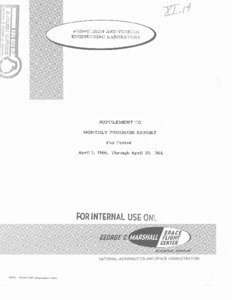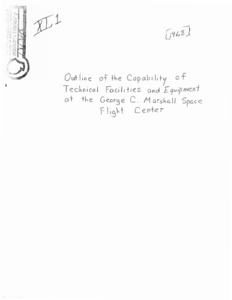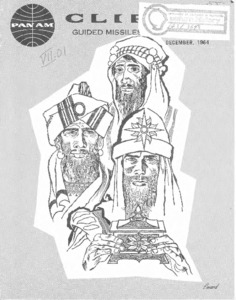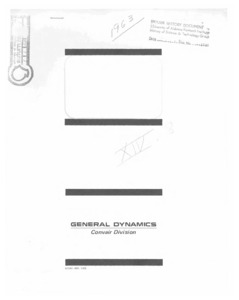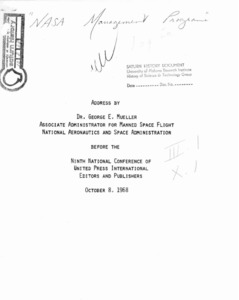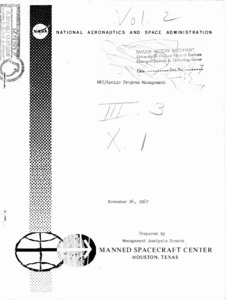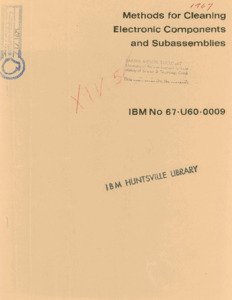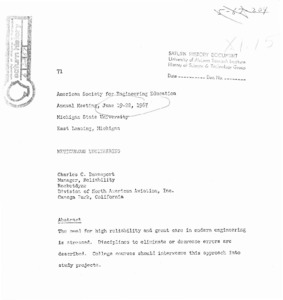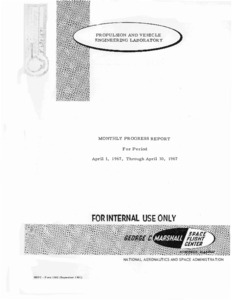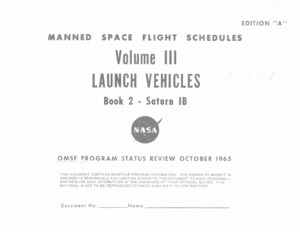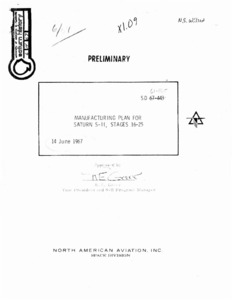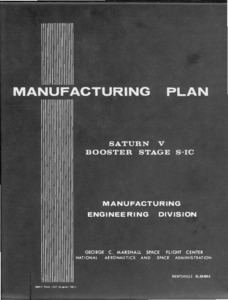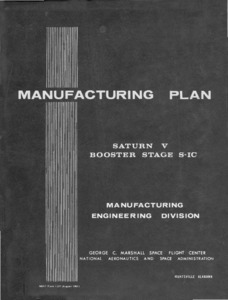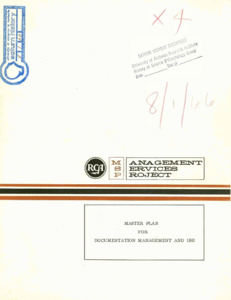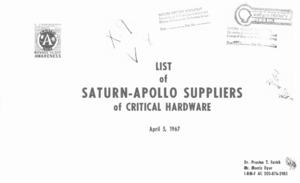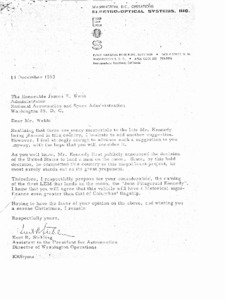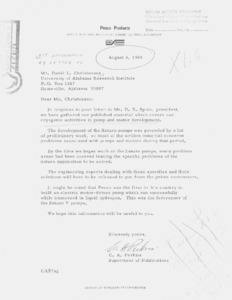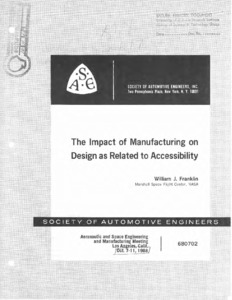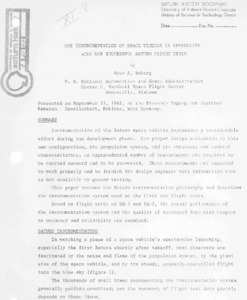
Browse Items (1965 total)
Sort by:
-
"Saturn S-II annual progress report 1 July 1963 through 30 June 1964."
This document is the second annual progress report of the Saturn S-II Program. The report provides a summary and technical analysis of results of contract work by the Space and Information Systems Division of North American Aviation, Inc., for the period 1 July 1963 through 30 June 1964. This document was prepared in compliance with NASA contract NAS7-200. -
"Saturn S-II stage program plan."
This documents outlines the S & ID plan to fulfill the requirements of Contracts NAS7-80 and NAS7-200 for the design, development and manufacture of the Saturn S-II stage.; APPROVED by R E. Greer, Vice President and S-II Program Manager.; This reissue supersedes all previous issues of this report.; FOREWORD: The S-II stage is 81.5 feet in length and 33 feet in diameter, with a usable propellant capacity of 970,000 pounds, The S-II propellants are fully cryogenic-liquid oxygen at -279 F and liquid hydrogen at -423 F. Its five-engine cluster provides one million pounds of thrust. The stage is a cylindrical structure of relatively light weight with a shell designed to resist all loads without the use of stiffening members. Its skin is of welded aluminum panels, as are the elliptical bulkheads of the fuel and oxidizer tanks. Unique to its design is the common bulkhead that separates the -423 F liquid hydrogen from the -247 F liquid oxygen. The common bulkhead - a sandwich of two 33-foot diameter aluminum domes separated by an insulating filler of honeycomb - eliminates the weight penalty that would be imposed by the second bulkhead in more conventional design. This document describes the S & ID program plan for development of the S-II stage and associated a support equipment. -
"Saturn IB inflight photographic instrumentation system."
This Internal Note presents the development of the Saturn inflight photographic instrumentation program from its original development requirement concept to the flight hardware application on Saturn vehicles. A comprehensive description of the infight photographic instrumentation system is given along with data concerning testing, operation, application, and evaluation of the system after recovery. This Internal Note shows that the system has been successfully developed,that valuable information has been obtained from film retrieved from recovered capsules, and that the system can be used with a high degree of reliability. -
"Saturn technical information handbook. Volume III of four volumes : SA-203."
The "Saturn Technical Information Handbook" provides up-to-date reference material to the Launch Operations Center personnel. This material shows the assembly and operation of the Saturn Vehicle components for systems analysis.; Volume II is available on the NASA Technical Reports Server (NTRS) as a PDF. -
"Report to the Congress from the President of the United States"
A report to Congress from White House regarding the accomplishments of NASA. -
"Ground testing at MSFC : research achievements review series no 9"
In 1955, the team which has become the Marshall Space Flight Center (MSFC) began to organize a research program within its various laboratories and offices. The purpose of the program was two-fold: first, to support existing development projects by research studies and second, to prepare future development projects by advancing the state of the art of rockets and space flight. Funding for this program came from the Army, Air Force, and Advanced Research Projects Agency. The effort during the first year was modest and involved relatively few tasks. The communication of results was, therefore, comparatively easy.; Pages of handwritten notes on yellow legal paper. There is also a 3 x 5 inch card with this information. Article reference for Saturn History Files: Schuler, Albert E. (NASA-MSFC) Research and development in instrumentation for static testing. -
"A review of the research origins of the LANCE weapon system -- Project hindsight -- Task 1 supplement."
This report includes a discussion of 57 research and exploratory development events that have been identified as contributing significantly to LANCE. Forty-six of these are research events. Eight of the research events deal with LANCE aerodynamics, four with propulsion, 24 with solid-state components used in the guidance and control system,and 10 with the research origins of the materials and manufacturing processes used in LANCE. In addition, 11 exploratory development events are identified. The principal concern of this study has been the identification of further research origins of LANCE and the 46 documented events are its major product. A further concern and obligation of this study has been to provide HINDSIGHT with some additional data on the research phenomenon including some further observations on the nature and route of research utilization.; FOREWORD: The purpose of this report is to present a survey of fundamental research contributing to the successful development of the LANCE weapon system. Included in this report are discussions of research inputs to a number of LANCE systems and technology areas. The circumstances of these research contributions to LANCE are discussed. The implications of these examples of research utilization are analyzed and some general observations and conclusions on the research payoff phenomena are given. This report was requested by the Army Missile Command as a supplemental contribution to Project HINDSIGHT.; Contract No. DA-01-021-AMC-14693(Z).; Battle Memorial Institute ,Columbus Laboratories.; RSIC-627.; Includes letter from W. Metscher, Lt. Col. to Mr. David L. Christensen dated March 14, 1969. -
"Project Dynasoar (u): a report bibliography."
Projected by D.L. Christiansen, DLC- 5/2/69-Memo.; Search control No. 015416.; For Scientific and Technical Information, Cameron Station, Alexandria, Virginia.; Unclassified.; Pages in this bibliography are not numbered. -
"Project Thor (u): a report Bibliography."
Unclassified control No. 015415.; Requested by D.L. Christensen, DLC-5/2/69-Memo for Scientific and Technical Information, Cameron Station, Alexandria. -
"Propulsion and Vehicle Engineering Laboratory monthly progress report (July 1, 1966 through July 31,1966)."
A collection of progress reports covering a large number of projects within the month of July, 1966 -
"Propulsion and Vehicle Engineering Laboratory monthly progress report (August 1, 1966 through August 31, 1966)."
A collection of progress reports covering a large number of projects within the month of August, 1966 -
"Propulsion and Vehicle Engineering Laboratory monthly progress report (November 1, 1966 through November 30, 1966)."
A collection of progress reports covering a large number of projects within the month of November, 1966 -
"Propulsion and Vehicle Engineering Laboratory monthly progress report (March 1, 1966 through March 31,1966)."
A collection of progress reports covering a large number of projects within the month of March, 1966 -
"R & D directory for 1962 (NASA-MSFC Contracts-1962)."
Excerpt of contracts MSFC 1962, pages 76-79. -
"Pratt & Whitney Aircraft RL10 liquid hydrogen rocket engine"
Photograph of a Pratt & Whitney rocket engine. -
"Preliminary skeletal operations plan for Apollo :" a systems engineering support document.
The Preliminary Skeletal Operations Plan is a statement of the operational concept for Apollo. This draft contains a description of the conduct of the Apollo LOR landing mission and a mission profile. It provides the basis for more detailed mission planning, for generating functional criteria for equipment design, and for measuring the adequacy of the current Apollo hardware for satisfying operational needs. -
"Proceedings : second NASA-wide reliability & quality assurance meeting : NASA Headquarters, November 29 - December 1, 1966."
The papers presented at the second NASA-Wide Reliability and Quality Assurance Meeting are published to disseminate current experiences and information. These papers, presented at NASA Headquarters on November 29 - December 1, 1966, are one means of exchanging current NASA reliability and quality assurance knowledge between projects and programs. This publication has been marked "FOR NASA USE" since it contains management opinions and contract experiences. Publication of papers suitable for wide dissemination in the Government, industry and University community is expected to be made separately. John E. Condon, Director, Reliability & Quality Assurance. -
"Propulsion and Vehicle Engineering Laboratory monthly progress report (April 1, 1966 through April 30, 1966)."
Progress report for the month of April, 1966. -
"Outline of the capability of technical facilities and equipment at the George C. Marshall Space Flight Center."
Outline of the equipment present at George C. Marshall Space Flight Center. -
"Pan Am Clipper : Guided Missiles Range Division : December, 1964."
A collection of articles, one of which musing about the landing on/colonization of Mars in the future. -
"NEXUS concept of a large reusable earth launch vehicle."
Aspects of Earth-to-orbit delivery are discussed and a cost analysis of the logistic operation and the cost of orbital operations are presented. Probabilities of success of orbital delivery and the operational and economic aspects of establishing large orbital installations and maintaining a large transportation volume in the 1975/85 time period are compared for the two cases using a large number of Saturn V versus a smaller number of 1-stage chemical Post-Saturn launch vehicles. Performance parameters of chemical, chemonuclear and nuclear launch vehicles are compared. The concept of a blunt launch vehicle configuration referred to as NEXUS is presented in detail. Applications of this configuration to chemonuclear propulsion and to a 50 ft diameter version of Saturn V with recoverable first stage are discussed. -
"H-1 rocket engine: models H-1C and H-1D : technical manual engine data."
Poor jpeg of a screenshot of a word-document. -
"NASA management programs."
Address by Dr. George E. Mueller, Associate Administrator for Manned Space Flight, National Aeronautics and Space Administration before the Ninth National Conference of United Press International Editors and Publishers, October 8, 1968. -
"NASA management programs."
Address by Dr. George E. Mueller, Associate Administrator for Manned Space Flight, National Aeronautics and Space Administration; Joint AIAA/CASI Meeting, Montreal, Canada, July 8, 1968. AS DELIVERED.; Includes charts. -
"Methods for cleaning electronic components and subassemblies."
In describing the cleaning of electronic components and subassemblies, it must be taken into consideration that each part to be cleaned presents an individual problem. The method of cleaning must be tailored to the type of part to be cleaned as well as to the type of soil to be removed. This paper reviews some of the methods used in cleaning electronic arts, particularly printed circuits, as well as other critical hardware which is used in support of electronic assemblies. Some of the methods covered include the use of abrasives, acids, solvents and alkalies, and the employment of these in combination with ultrasonic and other automatic systems. The clean room in use at IBM Huntsville is described briefly, along with the solutions and solvents used in cleaning electronic and supporting parts. Cleanliness- requirements for the area and the materials, together with procedures for meeting them give added emphasis to the critical nature of today's contamination control programs. The paper concludes with a summary of the cleaning procedures and the cleanroom benefits to be obtained by using present day technologies to improve them. -
"Meticulous engineering."
The need for high reliability and great care in modern engineering is stressed. Disciplines to eliminate or decrease errors are described. College courses should interweave this approach into study projects. -
"Michoud and Mississippi test operations : May 1965."
This document contains copies of management charts and photographs maintained in the Management Information Office of the Executive Staff on Michoud and Mississippi Test Operations. Information on other MSFC activities and facilities will be published in separate volumes as indicated on the following page. Most of these charges are included in Dr. von Braun's, Dr. Rees' and Mr. Gorman's Management Information Consoles. -
"Propulsion and Vehicle Engineering Laboratory monthly progress report (April 1, 1967, through April 30, 1967)."
Monthly progress report between the month of April. -
"Manned space flight schedules. Vol. III, launch vehicles : book 2, Saturn IB."
OMSF program status review October 1965.; Edition "A". -
"Manned space flight schedules. Vol. III, launch vehicles : book 3, Saturn V."
OMSF Program Status Review October 1965.; Edition "A". -
"Manufacturing plan for Saturn S-II, Stages 16-25."
Manufacturing plan for for SII stages 16 through 25. -
"Manufacturing plan : Saturn V : booster stage S-IC. Volume 2."
Manufacturing plan for Saturn V Booster stage S-IC -
"Manufacturing plan : Saturn V : booster stage S-IC. Volume 1."
This procedure provides the necessary information for the fabrication and assembly of the Saturn C-5 booster stage S-IC. The manufacturing methods outlined herein represent techniques that will be utilized both at Michoud and MSFC wherever possible. The concepts and methods outlined are of a preliminary nature consistent with the stage of design at this time. These concepts and methods are subject to change. This Manufacturing Plan will be periodically updated to reflect such changes. The processes and techniques proposed in this Manufacturing Plan are generally within the present state of the art, consistent with reliability requirements for manned space flight and advocated for use with the limited manufacturing facilities of the Marshall Space Flight Center and the Michoud Production Facility.; Includes memorandum dated 15 Jan. 1963 from J. H. Chesteen, Chief, Engineering Planning Section. M-ME-SE.; Includes memorandum from J. H. Chesteen and N. E. Johansen to W. B. Edmiston and W. R. Kuers--subject: Integration Boeing-MSFC Manufacturing plan. December 18, 1962. -
"Master plan for documentation management and use."
Prepared for National Aeronautics and Space Administration, George C. Marshall Space Flight Center, Huntsville, Alabama. Accepted by V.C. Sorensen, Chief, Management Services Office. Management Services Project, RCA; SUMMARY: The objective of this study is to describe a comprehensive plan for the development and full utilization of methods and means to be employed in the years prior to 1976 for the effective acquisition, collection, storage, retrieval, distribution, and use of engineering documentation. Because of the violently changing state of the art of data acquisition, storage, and retrieval the description of the plan does not embrace the details of a total decade of phased change. Rather it describes actions that can and should be taken in the relatively near future, and proposes a continuing series of later studies to keep this plan current for the full decade. -
"List of Saturn-Apollo Suppliers of Critical Hardware."
A list of critical hardware from Saturn-Apollo Suppliers. -
Letter to the Honorable James E. Webb, Administrator, National Aeronautics and Space Administration from Kurt R. Stehling.
A letter to Jame E. Webb proposing that the first LEM that lands on the moon to be named after President Kennedy." -
Letter to Honorable James E. Webb, Administrator, National Aeronautics and Space Administration from W. K. Wilson, Jr.
Letter to James Webb from W. K. Wilson regarding one of his studies. -
Letter to Mr. David L. Christensen.
Letter from C.A. Perkins to David L. Christensen regarding a request for information regarding cryogenic pump and motor development -
"The impact of manufacturing on design as related to accessibility."
The purpose of this paper is to emphasize the need for accessibility in the assembly and maintenance of spacecraft. This is especially pertinent because accessibility to subsystems for replacement, repair, and maintenance has proven to be one of the more costly phases of preflight preparation. The most successful programs in this day and age have been when the design and manufacturing engineers work side by side around a mockup where solutions to the problems can be visually seen and solved, keeping in mind the assembly as related to accessibility. Therefore, it will be shown that in order to overcome the difficulties, designers should adapt a hard, fast ground rule that each unit must be accessible and individually removable without disturbing the other units.; Aeronautic and Space Engineering and Manufacturing Meeting, Los Angeles, Calif. Oct. 7 - 11, 1968. -
"The instrumentation of space vehicle in connection with the successful Saturn flight tests."
Presented on September 21, 1962, at the Eleventh Tagung Der Deutchen Raketen - Gesellschaft, Koblenz, West Germany. Instrumentation sf the Saturn space vehicle represents a considerable effort during the development phase, for proper design evaluatian of this new configuration, its propulsion system, and its structure and control characteristics, an unprecedented number of measurements are required to be carried onboard and to be recovered, These measurements are expected to work properly and to furnish the design engineer with information that is not available by ground testing,
